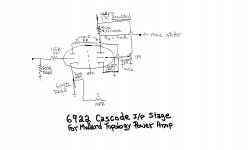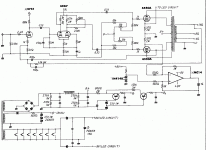I use LM317 as CCS for the 6SN7 long tail pair phase splitter. The minimum voltage for maintaining CCS is about 2Vdc. This is just good for this circuit. The very nice thing about using this CCS is that the plate load of 6SN7 can be the same. I checked the output voltage of the two triodes of 6SN7 are the same. No adjustment is necessary.
Johnny
Johnny
FWIW, i got better results when the long tail pair had a higher mu than the 6sn7, i used the 6sl7, would like to try the 12ax7 or 12dt7's....then a lower mu input voltage stage like the 6sn7 or the 12au7, seems to me a better combination in a 5-20 circuit...
The problem with types like the 6SL7 and 12AX7, in the LTP role, is a combination of high RP and low gm. That makes them poor candidates for driving anything other than full pentode mode "finals". If you insist on a high μ type in the LTP role, look towards the 12AT7/ECC81.
The "best" "Golden Age" implementation of Mullard style topology I'm aware of is the Harman-Kardon Citation V. Attention is called to Stu Hegeman's choice of high gm small signal types.
The "best" "Golden Age" implementation of Mullard style topology I'm aware of is the Harman-Kardon Citation V. Attention is called to Stu Hegeman's choice of high gm small signal types.
Attachments
12at7 is equivalent to 6sl7, imho, to use the 12ax7 means you need cathode followers or mosfet buffers...
rp, gm and such have contexts, so i will design them for maximum output swing instead of maximum gains...
rp, gm and such have contexts, so i will design them for maximum output swing instead of maximum gains...
The "best" "Golden Age" implementation of Mullard style topology I'm aware of is the Harman-Kardon Citation V. Attention is called to Stu Hegeman's choice of high gm small signal types.
The Citation II is potentially better with the pentode LTP and A to g1 feedback loop but not something an amateur can loosely adapt and take liberties with.
cascode ltp is also one way to do a pentode ltp, Geek has a circuit posted here over 10+ years ago......CCSed LTP validity? 30W UL 6L6P-P amp
More gain from a LTP ?
maybe run a pair of EF-86, with the CCS and other stuff, and then maybe a cathode follower / buffer to the power tubes ?
Last time I did a LTP, I used a choke tail instead of resistor tail.
But , if I ever do a PI again, pretty sure I just use an in-line transformer for that....
maybe run a pair of EF-86, with the CCS and other stuff, and then maybe a cathode follower / buffer to the power tubes ?
Last time I did a LTP, I used a choke tail instead of resistor tail.
But , if I ever do a PI again, pretty sure I just use an in-line transformer for that....
How about using input bridging transformer to split the phase so you wouldn't even need LTP and you can run feedbacks to the cathodes. Jensen has some nice 1:1 ratio models that are suitable.
Well, it has been kind of interesting to read this thread more then 10 years after my original question!
1. Just recently I came across an article that describes one of the here proposed solutions: cascode LTP.
I even uses similar valves at a similar operating point as I was trying back then.
http://www.keith-snook.info/wireles...A.F. Amplifier - Long-tailed cascode pair.pdf
Note the use of 7N7(6SN7) and 7F7(6SL7), the ECC88 was only released two years after the article!
2. I'm amazed no one has talked about Allen Wright (R.I.P.) and his love for the cascode LTP in this thread yet. One example here: Vacuum State - High End Hifi Equipment
1. Just recently I came across an article that describes one of the here proposed solutions: cascode LTP.
I even uses similar valves at a similar operating point as I was trying back then.
http://www.keith-snook.info/wireles...A.F. Amplifier - Long-tailed cascode pair.pdf
Note the use of 7N7(6SN7) and 7F7(6SL7), the ECC88 was only released two years after the article!
2. I'm amazed no one has talked about Allen Wright (R.I.P.) and his love for the cascode LTP in this thread yet. One example here: Vacuum State - High End Hifi Equipment
Last edited:
I've played with hybrid-cascoded ccs-tailed LTP, with njfet on bottom and 12AX7 on top, and it sounds clean and defined but almost SS. Now I'm approaching the opposite, with a 12AX7 on bottom and a BJT on top to see if I can get a more tubeish sound.
Has anyone experience with that configuration?
Thanks
Has anyone experience with that configuration?
Thanks
I do not. As I mentioned, I use a choke tail instead of anything else, and then just call it a day. The resistive script from the choke provides the bulk of the dc bias for both of the gain stages .
The problem with types like the 6SL7 and 12AX7, in the LTP role, is a combination of high RP and low gm. That makes them poor candidates for driving anything other than full pentode mode "finals". If you insist on a high μ type in the LTP role, look towards the 12AT7/ECC81.
The "best" "Golden Age" implementation of Mullard style topology I'm aware of is the Harman-Kardon Citation V. Attention is called to Stu Hegeman's choice of high gm small signal types.
The Citation V circuit has been on my radar for a while.
1. What pentode do you suggest to sub in for the 12BY7?
2. What simple CCS system for underneath the 6CG7? I haven't done one yet.
3. 6SN7 fine to sub in for the 6CG7?
I have some Toroidy's that might fit the bill for the outputs.
Attachments
The Citation V circuit has been on my radar for a while.
1. What pentode do you suggest to sub in for the 12BY7?
2. What simple CCS system for underneath the 6CG7? I haven't done one yet.
3. 6SN7 fine to sub in for the 6CG7?
I have some Toroidy's that might fit the bill for the outputs.
1. 11hm7, 12gn7, 12hg7, D3a, 6jh52,
2. depletion mosfets, dn2540, etc
3. yes
Another circuit that has good reputation is the Connie J MV75. Anyone care to compare/contrast to the Citation V?
the difference here is the cap coupling between input voltage amp and the long tail pair splitter, i have yet to make an amp like this, i prefer dc coupling, although this topology has some merits....i guess it is just my aversion to too many coupling caps, reason i also do not want to do a williamson....to me Mullard 5-20 topology is enough...looking forward to build a radford...

Last edited:
Tony,
Williamson topology requires careful spacing of the RC poles F3, lest UNWANTED fulfillment of Barkhausen's criterion for oscillation occur. Good quality O/P "iron" is also in order. Getting some "armor plate" over Williamson style circuitry's "Achilles Heel" of low frequency instability is possible.
Williamson topology requires careful spacing of the RC poles F3, lest UNWANTED fulfillment of Barkhausen's criterion for oscillation occur. Good quality O/P "iron" is also in order. Getting some "armor plate" over Williamson style circuitry's "Achilles Heel" of low frequency instability is possible.
Tony,
Williamson topology requires careful spacing of the RC poles F3, lest UNWANTED fulfillment of Barkhausen's criterion for oscillation occur. Good quality O/P "iron" is also in order. Getting some "armor plate" over Williamson style circuitry's "Achilles Heel" of low frequency instability is possible.
thanks....
would increasing the open loop gain in a williamson help? like instead of 12au7's the 6072's are used instead...
- Home
- Amplifiers
- Tubes / Valves
- long tailed pair - need more gain


